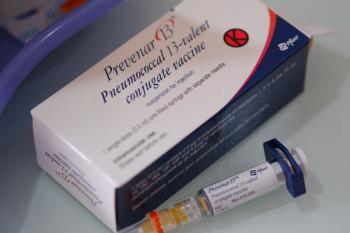
Flu Vaccination Could Help Reduce Hospitalization for RSV
A Western Australian study found the influenza vaccine has a possible protective effect against hospitalization for respiratory syncytial virus (RSV).
A vaccination for influenza could have protective qualities against infection of respiratory syncytial virus (RSV), according to a study published in Vaccine.1
Nonspecific effects on the burden of disease have been found in vaccines in recent years. The present study's researchers aimed to assess vaccination for influenza affects hospitalizations due to RSV in children, as both viruses have cocirculated with other respiratory viruses.
Longitudinal data for all children from Western Australia who were born between 2000 and 2012 were used for this study. Influenza vaccine uptake, hospitalizations, and microbiology testing records were collected from birth until age 7 years or December 31, 2013, whichever came first. Sociodemographic details for both parents and maternal medical history, labor, delivery, and infant health at birth were also included.
The Australian Childhood Immunization Register was used to collect data on vaccination date, vaccine type, and dose number for children from birth to age 7 years. This register contains data on 99% of all Australian children. Hospital admissions and up to 21 discharge diagnosis fields were included in the hospitalization data.
The outcome for this study was the annual hospitalizations for laboratory-confirmed RSV that occurred between January 2000 and December 2013, with primary exposure being the receipt of the annual influenza vaccine. All children aged 6 months to 5 years were eligible for a free vaccine in Western Australia starting in 2008.
There were 360,994 children in the cohort, of which 6.4% (23,107) were Aboriginal and 12% (12,141) were positive for RSV. Children younger than 2 years made up 90% of hospitalizations for RSV; the highest rate of hospitalization was found in children younger than 6 months. Children with low socioeconomic backgrounds, those born preterm or with low birthweight, or those who were born to a mother who smoked while pregnant or was younger than 20 years had a higher risk of hospitalization for RSV.
Vaccination coverage was highest in 2009 when 26% of children aged 6 months to 7 years had received their vaccination. Although the crude hospitalization rates for RSV in those who received their influenza vaccine was comparable with those who didn’t, there was a reduction in hospitalization rate from 2008 to 2013 when the state funded the preschool influenza vaccination policy.
Hospitalization for RSV decreased when a child received their influenza vaccine. Rate reductions of 2.27 (95% CI, –3.26 to –1.28) per 1000 population was found in children younger than 2 years and 0.53 (95% CI, –1.04 to –0.02) per 1000 in children aged 2 to 7 years.
The researchers concluded that the preschool-funded influenza vaccine program was able to reduce hospitalizations for RSV by 793 hospitalizations in children who are younger than 2 years and 400 hospitalizations in children aged 2 to 7 years from 2008 to 2013.
Potential limitations on these findings include that correlation in error terms over time were not considered and the time-varying nature of hospitalization for RSV and seasonal influenza vaccination was not taken into account. The study also did not distinguish the different brands and strains of the influenza vaccine.
The investigators concluded that there is a possible protective effect of the influenza vaccine on hospitalizations for RSV in children in Western Australia.
Reference
1. Le H, de Klerk N, Blyth CC, Gidding H, Fathima P, Moore HC. Non-specific benefit of seasonal influenza vaccine on respiratory syncytial virus-hospitalizations in children: an instrumental variable approach using population-based data. Vaccine. Published online July 6, 2023. doi:10.1016/j.vaccine.2023.06.085
Newsletter
Pharmacy practice is always changing. Stay ahead of the curve with the Drug Topics newsletter and get the latest drug information, industry trends, and patient care tips.





























































































































